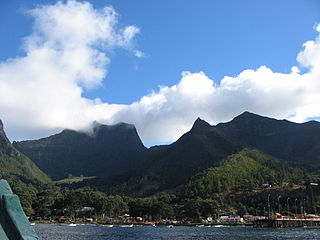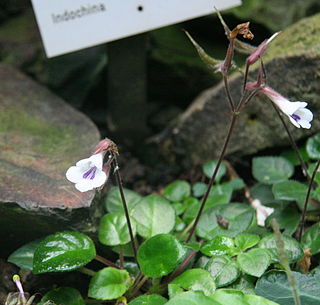
Broussonetia is a genus of four species of trees in the family Moraceae, native to eastern Asia. These four species have high-quality fiber which consist of more than 90% of cellulose. They are traditionally applied for various daily necessities in South Eastern Asia and papermaking in East Asia.

Chirita was a formerly recognised genus of plants in the family Gesneriaceae, native to the Indo-Malayan realm of South and Southeast Asia and southern China. In 2011, the species in the genus were reassigned to several genera, so that Chirita became a synonym, no longer recognized. The type species C. urticifolia was assigned to the genus Henckelia as H. urticifolia(Buch.-Ham. ex D. Don.) A. Dietr.

The Lâm Viên Plateau is a plateau in southeastern Vietnam. At its centre is the city of Da Lat. Several mountains in this area rise to over 2,000 m (6,562 ft), the highest being Chư Yang Sin Summit at 2,442 m (8,012 ft).

Archipiélago de Juan Fernández National Park is a national park located in the Pacific Ocean 665 kilometres west of Chile's mainland port of San Antonio, in the Juan Fernández Archipelago. The park covers 96 square kilometres and comprises the Santa Clara, Alejandro Selkirk and the most part of the Robinson Crusoe Island islands.
Bidoup Nui Ba National Park is a national park in districts of Đam Rông and Lạc Dương, in the province of Lâm Đồng, Vietnam.

Primulina is a genus of flowering plants in the African violet family Gesneriaceae. It includes 232 species native to southern and north-central China and northern Vietnam. The species are mostly calciphilous, and typically grow in the extensive limestone karst regions of China and Vietnam.

Metapetrocosmea eberhardtii is a species of flowering plant in the family Gesneriaceae. It is a perennial native to central Vietnam.

Dorcoceras is a genus of flowering plants in the African violet family Gesneriaceae, native to Assam, Southeast Asia, China and central Malesia. Its species were transferred from the genus Boea in 2016.
Billolivia is a genus of flowering plants belonging to the family Gesneriaceae.
Petrocodon is a genus of the family Gesneriaceae. It includes 51 species native to southern China and Indochina. Petrocodon formerly had few species, but recent genetic analysis has refined our understanding of the genus. Calcareoboea, Paralagarosolen, Dolicholoma, and Tengia monotypic genera have been transferred to Petrocodon, as well as some Didymocarpus and Lagarosolen species.

Metapetrocosmea is a genus of flowering plants belonging to the family Gesneriaceae. It includes ten species native to southern China, Hainan, and Vietnam.
Raphiocarpus is a genus of flowering plants belonging to the family Gesneriaceae.
Primulina halongensis is a plant in the family Gesneriaceae, native to Vietnam. The specific epithet halongensis is for Hạ Long Bay, where the species is found. It was formerly placed in the genus Chirita.
Primulina hiepii is a plant in the family Gesneriaceae, native to Vietnam. It is named for the Vietnamese botanist Tiên Hiêp Nguyên. The species was formerly placed in the genus Chirita.
Primulina modesta is a plant in the family Gesneriaceae, native to Vietnam. It was formerly placed in the genus Chirita.
Primulina drakei is a plant in the family Gesneriaceae, native to Vietnam. The species was formerly placed in the genus Chirita.
Primulina gemella is a plant in the family Gesneriaceae, native to Vietnam. The species was formerly placed in the genus Chirita.
Aspidistra phongdiensis is a species of flowering plant in the genus Aspidistra. It is endemic to central Vietnam and was known from Phong Dien Nature Reserve, Thua Thien Hue.
Middletonia is a genus of flowering plants in the family Gesneriaceae. It includes five species native to Asia, ranging from the eastern Himalayas through Indochina to Peninsular Malaysia and southern China.

Anna is a genus of flowering plants in the family Gesneriaceae. It includes four species native to Vietnam and southern China.








